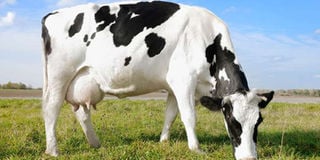Kikuyu grass: green gold revered abroad, underrated at home

A dairy cow grazing. On vigorous Kikuyu pastures alone, dairy cows can produce over 15 litres of milk daily while beef animals can yield over 400kg of live weight per hectare of land annually. FILE PHOTO | NATION MEDIA GROUP
What you need to know:
- When provided at the right stage of growth, the grass is a highly nutritious pasture species that is excellent for dairy and beef animals, including sheep and goats.
- It is also famed for its ability to quickly cover the ground, especially under optimum moisture and soil fertility conditions.
- Kikuyu grass is known to tolerate acidic soils (of up to 4.5 pH level) as well as moderate salinity.
- For good silage fermentation, Kikuyu grass needs to be wilted first or have extra sugar in form of diluted molasses added because of its relatively low dry matter content and low water soluble carbohydrate content.
For many livestock farmers, Kikuyu grass has been this ever-present, little value pasture species that their animals seem to have a liking for.
In the Americas, Asia, Australia and New Zealand, however, this fodder species is highly revered but limited, with some companies making a fortune out of it, both as fodder and lawns.
Kikuyu grass, as the name suggests is native to Kenya and its neighbouring nations, yet many farmers are not aware of the immense value of the resilient species.
When provided at the right stage of growth, the grass is a highly nutritious pasture species that is excellent for dairy and beef animals, including sheep and goats.
It is also famed for its ability to quickly cover the ground, especially under optimum moisture and soil fertility conditions.
Interestingly, many don’t know, the grass can readily be conserved as silage, thus, storing it at the perfect stage of growth with most of the nutrients intact.
The grass is a stoloniferous and rhizomatous perennial, meaning that it can spread fast and persist for many years.
Its stolons (stems) are much-branched and grow parallel to the ground forming a turf under regular defoliation, which easily smothers growth of weeds and other unwanted grass species.
On average, this species grows to a height of about 35cm tall, especially with regular fertiliser top-dressing.
The grass grows best on moderately drained and high fertility loam, red basalt or clay soils though it can also still do well on alluvial and fertilised moist sandy soils.
(Read also: Hay, growing fodder is good business)
Kikuyu grass is known to tolerate acidic soils (of up to 4.5 pH level) as well as moderate salinity. It thrives in cool areas (16°C – 21°C) with an annual rainfall of between 800 and 1,600mm but performs well under irrigation in lower rainfall areas.
Most active growth happens during periods of high humidity and suppressed growth is witnessed in dry seasons.
The grass is known to significantly tolerate frost and waterlogging. Thanks to its deep root, Kikuyu grass is moderately drought-resistant.
USE AS FODDER
When well-fertilised, Kikuyu grass produces very high quality feed with about 24 per cent Crude Protein (CP) content.
Remember that crude protein is usually the most limiting nutrient in pasture based (grazing) systems. CP levels, however, tend to decline with maturity and increased stem to leaf ratio as the crude fibre levels increase.
Generally, this means that with growth of over a foot, the nutritional value decreases as well as the digestibility. Young growth is very soft and palatable, but older is not relished by most animals.
The presence of a legume in the sward increases utilisation of the grass.
The best stage to utilise Kikuyu grass is when the upshot branches have between four to five leaf blades each. The grass can be grazed directly or harvested and stored as silage.
With grazing, it is highly recommended that rotational or strip grazing is used to ensure maximum utility of the crop and avoid wastage.
Such grazing systems require proper planning to ensure that the grass is at the optimal growth (4-5 leaf-stage) at the time of utilisation.
For good silage fermentation, Kikuyu grass needs to be wilted first or have extra sugar in form of diluted molasses added because of its relatively low dry matter content and low water soluble carbohydrate content.
On vigorous Kikuyu pastures alone, dairy cows can produce over 15 litres of milk daily while beef animals can yield over 400kg of live weight per hectare of land annually.
How to establish and manage the pasture
Kikuyu grass is readily established vegetatively or from seeds. Harvested pieces of rhizome or stolons with about three nodes each can be planted in regular furrows (about 8 feet deep).
Subsequent rolling ensures better establishment while seed is sown at 1–2kg per hectare.
Good moisture conditions for several days after sowing are essential for effective establishment. The grass is particularly demanding of nitrogen and phosphorous soil nutrients.
Therefore, it is important to fertilise Kikuyu grass after every cycle of grazing or mowing using nitrogenous and phosphatic fertilisers.
One can use 50 to 100kg of CAN fertiliser per hectare. In addition, manure slurry can be spread on the field to boost soil phosphorous levels.
Regular defoliation is necessary to maintain forage quality and palatability of the stand. Management should aim to maximise the amount of leaf, and minimise the amount of stem.
Accordingly, stands should be grazed to about 5cm in height and allowed to regrow to about 15cm.
If pasture height exceeds 1 cm, it is best to mow the sward back to 5cm to remove stems and mature growth.
Dry matter yields are only limited by soil fertility and moisture availability.
Under optimum conditions, it is capable of producing 30 tonnes per hectare every year, but is less productive if not well fertilised.
***
Kimitei is based in the Department of Animal Sciences, Egerton University.
Limitations
- Requires fertile soils for persistence and production.
- Competitive against many legumes.
- Rhizomes can create weed problem.
- Susceptible to ‘Kikuyu yellows’ disease.




